Martin Edwards's Blog, page 133
December 13, 2017
Francis Durbrige Presents: Bat Out of Hell - DVD review -
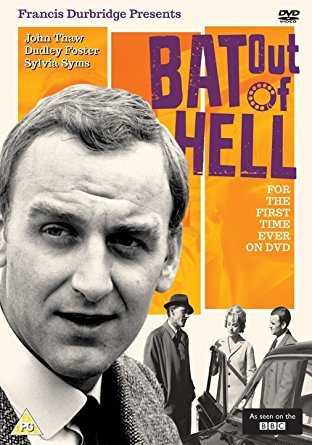
My introduction to Francis Durbridge came when I was a boy. I happened to watch his TV serial Bat Out of Hell when it was screened by the BBC in 1966. Not long before, I'd discovered Sherlock Holmes and Agatha Christie, whom I still admire. And Durbridge, too, is a master of the crime genre, with a particular flair for the cliffhanger. I've watched and listened to many of his serials for TV and radio, and read many of his books. But Bat Out of Hell remains my favourite of his works.
There are several reasons for this. First, it's not formulaic. In fact, the structure is highly original. We are presented, it seems, with a classic "inverted mystery" scenario. Geoffrey Stewart is a wealthy estate agent but his marriage to the much younger Diana is fraying. We soon discover that Diana is having an affair with Mark Paxton, who works for Geoffrey, and that they are conspiring to murder him for his money. The crime is duly committed - but then the fun really starts. For the body vanishes, and Diana receives a telephone call, evidently from Geoffrey. For good measure, a body turns up in the spot where Paxton had intended to bury Geoffrey. But the corpse isn't Geoffrey's.
All this in episode one, lasting a mere half hour. Old TV crime shows often suffer from a lack of pace by modern standards, but not Bat Out of Hell. The twists keep coming, as relentless as they are baffling. I can't think of any inverted mystery with such an ingenious plot, and the investigating detective, Inspector Clay is truly remorseless as Paxton and Diana find themselves living a nightmare. Durbridge's novelisation of the story, by the way, is a good one, and a few years back I encouraged Arcturus to republish it in their Classic Crime series. Copies are still easy to find.
Back to the TV series. Apart from the cleverness of the plot, the impressive pace, and a memorable cop, the five-part show also benefited from a superb cast. Paxton is played by the young John Thaw - yes, Inspector Morse himself. Diana is played by Sylvia Sims, at her most beautiful. The inspector is played by Dudley Foster, a terrific character actor whose career was sadly ended when he committed suicide. The supporting cast, also very good, includes Noel Johnson, Patsy Smart, and June Ellis, best remembered for appearing in the "Waldorf Salad" episode of Fawlty Towers.
And here's another little gem for fellow trivia lovers. Half-way through the first episode, I was startled to hear a piece of background music that seemed very familiar. But I know it as the theme from Callan, a TV series of a later vintage. It was given the title "Girl in the Dark" and was a piece of stock library music. The composer was Jack Trombey, who later wrote the theme for Van Der Valk, which became a number one hit as Eye Level for the Simon Park Orchestra.
I'm delighted that Bat Out of Hell is now available on DVD, and I loved watching it again, fifty years on. It's worn better than many TV series of that era, in my opinion. And I can see exactly why it made a very big impression on the admittedly impressionable young Martin Edwards.
Published on December 13, 2017 01:00
December 11, 2017
Marian, Mary, Tim - rest in peace
I'm sorry to report the deaths of three people, two of them friends of mine, during the course of the past few days. First, Marian Babson, whose real name was Ruth Stenstreem, and who was 88. She served as Secretary of the CWA for many years, and was a prolific writer of traditional detective novels from 1971 onwards. She was also a worthy winner of the CWA Dagger in the Library, and a member of the Detection Club. On a number of occasions, she sent me copies of nice reviews of my books that she'd spotted in American magazines and newspapers, a kindness I much appreciated. She was a reserved, private person, and in recent years, she's been in very poor health, but it's still sad that she's no longer with us.
Mary Kelly was someone I never met, because her relatively brief writing career ended long before mine began. She was, however, a writer of high calibre, and her 1961 novel, The Spoilt Kill, won the CWA Gold Dagger award. She too joined the Detection Club, and became its Secretary. There's a lovely anecdote about her in Peter Lovesey's recollections at the end of Motives for Murder, when she was hiding from an editor who wanted to know where her latest book was. She never produced it; writer's block seems to have been the culprit. She'd not been involved with either the Club or the CWA for many years, but her work deserves to be remembered. She was 90.
Not a crime writer, but a stalwart of our community and a delightful and witty man, was Tim Cleeves, who died on Saturday. I first got to know him and his wife Ann at the end of the 80s, and I still vividly remember staying at their house in Whitley Bay with my wife and small children when Ann, Bob Barnard, Val McDermid, Chaz Brenchley, Reg Hill, and I were working on the first CWA northern chapter anthology. Tim and Helena took their and our children off to Newcastle while the writers talked crime. We've had plenty of times together since, but what I find very poignant is that Tim and I had a couple of long conversations only a few weeks ago at the Daggers dinner, when he and the girls were so proud to see Ann receive the CWA Diamond Dagger. His sudden death is a real tragedy, and the thoughts of crime writers and readers will be with Ann, Sarah, and Ruth at this sad time.
Mary Kelly was someone I never met, because her relatively brief writing career ended long before mine began. She was, however, a writer of high calibre, and her 1961 novel, The Spoilt Kill, won the CWA Gold Dagger award. She too joined the Detection Club, and became its Secretary. There's a lovely anecdote about her in Peter Lovesey's recollections at the end of Motives for Murder, when she was hiding from an editor who wanted to know where her latest book was. She never produced it; writer's block seems to have been the culprit. She'd not been involved with either the Club or the CWA for many years, but her work deserves to be remembered. She was 90.
Not a crime writer, but a stalwart of our community and a delightful and witty man, was Tim Cleeves, who died on Saturday. I first got to know him and his wife Ann at the end of the 80s, and I still vividly remember staying at their house in Whitley Bay with my wife and small children when Ann, Bob Barnard, Val McDermid, Chaz Brenchley, Reg Hill, and I were working on the first CWA northern chapter anthology. Tim and Helena took their and our children off to Newcastle while the writers talked crime. We've had plenty of times together since, but what I find very poignant is that Tim and I had a couple of long conversations only a few weeks ago at the Daggers dinner, when he and the girls were so proud to see Ann receive the CWA Diamond Dagger. His sudden death is a real tragedy, and the thoughts of crime writers and readers will be with Ann, Sarah, and Ruth at this sad time.
Published on December 11, 2017 09:00
Reading Reviews
[image error]
[image error]
Is it wise for writers to read reviews of their own books? Or is it simply a recipe for frustration and occasional rage, when the brilliance of one's efforts is ignored, and the reviewer displays a lamentable lack of enthusiasm, or even scorn? Writers invest a lot of time and effort in their work, and often a great deal of heartfelt emotion. So it's easy to become upset. And human nature means that bad reviews often make more of an impact than good reviews.
It's bound to be a purely personal matter for each writer as to the stance they take on reviews. My own attitude is influenced by the fact that I've been reviewing books for over 30 years, so I can see things from the reviewer's perspective as well as from the author's. As a writer, I'm interested in constructive reviews of my books, even if I don't agree with everything the reviewer says. We all make mistakes - critics as well as authors.
Of course, like everyone, I am very pleased when people say nice things about my books. And last week I was lucky enough to get two wonderful and very extensive reviews of two of my non-fiction works. The Invisible Event blog gave fantastic coverage to The Golden Age of Murder. I am still pinching myself about the fact that this book continues to sell well, even the hardback edition, which was published two and a half years ago.
And then the online library Interesting Literature discussed The Story of Classic Crime in 100 Books in depth, and in a way that again I found truly gratifying. And to see the book appear in Crimesquad's Christmas Top Ten (along with the Folio Society set for which I wrote an intro) was also delightful.
What is especially satisfying is that both reviewers "got" what I was trying to do. And this is, to my mind, the key to reviewing. When one judges a book, it is best to judge it in the light of what the author's objectives were - not, or not mainly, by what the reviewer thinks the author's objectives should have been. Criticism that is sympathetic and constructive, and which strives not to be hurtful, is to my mind not just entirely proper, but well worth studying. One can learn from such criticism, in exactly the same way as one can learn from criticism of a first draft from a good editor. And anyway, you can't please all the people all of the time. If one sends a book out into the world, one has to be somewhat philosophical about the reaction, hard though that can be. Probably the worst scenario is for there to be no reaction at all!
Criticism that is unpleasantly expressed or reflects the reviewer's personal hang-ups (or vanity, or ignorance) is a waste of time, and not worth bothering with. And even the finest critics can sometimes err on the side of acerbity. I have huge admiration for both Dorothy L. Sayers and Julian Symons as critics, but occasionally I feel they overdid the brutality. Because they were people of great distinction, this must have caused quite a bit of hurt. I think that in later life Symons recognised this, and some (but not all) of his judgements mellowed. It was, in my opinion, a change for the better. In reviewing, as in life, a reasonable amount of tolerance is a very good thing.
Published on December 11, 2017 05:42
December 8, 2017
Forgotten Book - The File on Lester
The name of Andrew Garve isn't as well-known today as it might be, despite the fact that Bello have made much of his work available again. I think that he, like his contemporary (and CWA and Detection Club colleague) Michael Gilbert suffered because of his refusal to be typecast, and his reluctance to write about series characters. He was a prolific and capable writer, who at his best was very, very good.
I've read a number of Garve's books, and I was tempted to try The File on Lester by an article that John Cooper contributed to the latest issue of CADS. John is an excellent judge, and he expressed great admiration for this book. Having read it, I can see why. It's extremely readable (smoothness of writing was something else Garve had in common with Gilbert) and the storyline is highly intriguing.
The eponymous Lester is a fast-rising star in the political firmament. He's just become leader of the Opposition, at a time when the government is unpopular, and facing a general election. Within a short time, Lester could be walking into 10 Downing Street. Then disaster strikes. An attractive young woman lets slip the information that, more than six months earlier, she and Lester had a brief affair. Lester is a widower, and there's nothing terribly scandalous about what happened. But Lester denies that he ever met the young woman, and his apparent deceit creates a furore.
The story is told in a series of documents, including reports from people working on a newspaper sympathetic to Lester. This method of story-telling can work very well, and Garve does a really good job of building the tension. There's an obvious explanation for what has happened to Lester, but it's not the right explanation. I enjoyed finding out the truth, and I now share John Cooper's enthusiasm for this highly entertaining novel.
I've read a number of Garve's books, and I was tempted to try The File on Lester by an article that John Cooper contributed to the latest issue of CADS. John is an excellent judge, and he expressed great admiration for this book. Having read it, I can see why. It's extremely readable (smoothness of writing was something else Garve had in common with Gilbert) and the storyline is highly intriguing.
The eponymous Lester is a fast-rising star in the political firmament. He's just become leader of the Opposition, at a time when the government is unpopular, and facing a general election. Within a short time, Lester could be walking into 10 Downing Street. Then disaster strikes. An attractive young woman lets slip the information that, more than six months earlier, she and Lester had a brief affair. Lester is a widower, and there's nothing terribly scandalous about what happened. But Lester denies that he ever met the young woman, and his apparent deceit creates a furore.
The story is told in a series of documents, including reports from people working on a newspaper sympathetic to Lester. This method of story-telling can work very well, and Garve does a really good job of building the tension. There's an obvious explanation for what has happened to Lester, but it's not the right explanation. I enjoyed finding out the truth, and I now share John Cooper's enthusiasm for this highly entertaining novel.
Published on December 08, 2017 14:24
December 6, 2017
The Night Has Eyes - 1942 film review
The Night Has Eyes is a British film, released in 1942, and not to be confused with Cornell Woolrich's Night Has a Thousand Eyes, which was published three years later and subsequently turned into a good film starring Edward G. Robinson. The British film also had two alternative titles in the US - Terror House and Moonlight Madness. No prizes for guessing which title I prefer.
The Night Has Eyes is based on a thriller by Alan Kennington which was published in 1939. I know very little about Kennington, though apparently in later life he was friendly with the better-known (yet still under-estimated) P. M. Hubbard. The film version of his book is in some respects creaky and melodramatic, as well as fog-shrouded, but it has a number of redeeming features.
One of these is the performance of James Mason as Stephen Dermid, a composer who has suffered severe shell-shock after being wounded while fighting in the Spanish Civil War. Mason manages, not for the only time in his career, to combine the charming with the sinister. A young teacher called Marian (Joyce Howard) falls for him after travelling to the Yorkshire moors with her American chum (Tucker McGuire) to try to discover the fate of her friend Evelyn, who disappeared a year ago.
Stephen is cared for by a housekeeper, Mrs Ranger (Mary Clare, an actress of real ability who played the very different part of Mrs Pym of Scotland Yard) and an odd-job man, Jim. Unfortunately for Marian, it becomes increasingly clear that something terrible happened to Evelyn, and before long she is at risk of suffering a similar fate. Despite the presentation of Yorkshire, a county I love, as a wild blend of fog and bog, and not much else, I found the film rather entertaining.
The Night Has Eyes is based on a thriller by Alan Kennington which was published in 1939. I know very little about Kennington, though apparently in later life he was friendly with the better-known (yet still under-estimated) P. M. Hubbard. The film version of his book is in some respects creaky and melodramatic, as well as fog-shrouded, but it has a number of redeeming features.
One of these is the performance of James Mason as Stephen Dermid, a composer who has suffered severe shell-shock after being wounded while fighting in the Spanish Civil War. Mason manages, not for the only time in his career, to combine the charming with the sinister. A young teacher called Marian (Joyce Howard) falls for him after travelling to the Yorkshire moors with her American chum (Tucker McGuire) to try to discover the fate of her friend Evelyn, who disappeared a year ago.
Stephen is cared for by a housekeeper, Mrs Ranger (Mary Clare, an actress of real ability who played the very different part of Mrs Pym of Scotland Yard) and an odd-job man, Jim. Unfortunately for Marian, it becomes increasingly clear that something terrible happened to Evelyn, and before long she is at risk of suffering a similar fate. Despite the presentation of Yorkshire, a county I love, as a wild blend of fog and bog, and not much else, I found the film rather entertaining.
Published on December 06, 2017 04:30
December 4, 2017
Books for Christmas
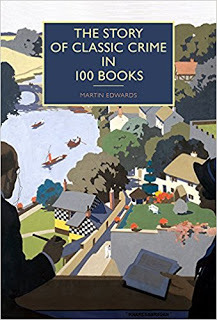
Tomorrow evening I'll be at the British Library, where there will be a Christmas shopping evening, and this has prompted me to give a plug to some of the books I've been involved with recently in the hope that if you're casting around for present ideas, you may be tempted. At least there are plenty of options to choose from this year!
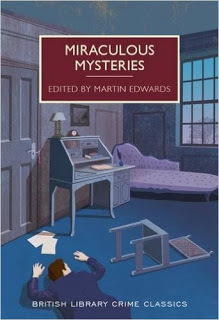
For me,the publishing highlight of the year has been the appearance of The Story of Classic Crime in 100 Books. The reviews, here and in the US, have been fantastic, and the sales have been equally gratifying. At times in the past, I've found that great reviews don't always lead to great sales, but this year has been a happy exception.

And then there are the British Library anthologies that I've put together this year. Miraculous Mysteries, Continental Crimes, The Long Arm of the Law, and Foreign Bodies. Each very distinctive, but each an attempt to combine rarities from obscure authors with stories by more familiar name, always with an emphasis on variety around a common theme.
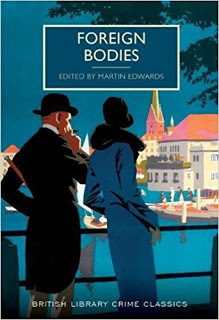
The British Library has brought out a new Crime Classic each month, and the series now numbers 50 books, which I find rather wonderful. The hardback edition of Anne Meredith's Portrait of a Murderer contains an extended essay of mine about Christmas crime. And of course my earlier seasonal anthologies, Silent Nights and Crimson Snow, are still very much available.
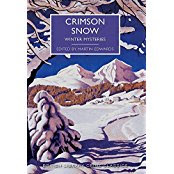
With other publishers, I've undertaken a variety of projects. I'm thrilled that the Dorothy L. Sayers Society brought out Taking Detective Stories Seriously, the Sayers reviews that I edited and wrote a commentary for. And a project I haven't mentioned previously on this blog is the Folio Society's lovely collection of three classic locked room mysteries (by Gaston Leroux, Edgar Wallace, and John Dickson Carr), for which I wrote an extended introductory essay. A beautifully produced set of books.

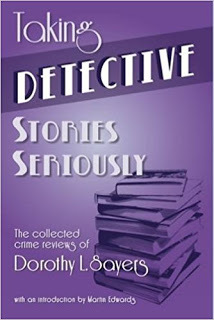
Also rather lovely to look at is Flame Tree's Agents and Spies, for which I wrote a short intro. I'm a fan of the Detective Story Club, and I enjoyed renewing my acquaintance with E.C. Bentley when writing an intro for Trent's Own Case. There are two more books in this series for which I've written intros - more details next year.
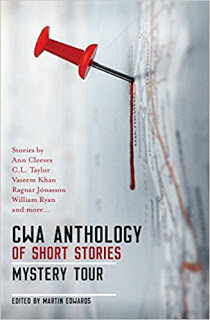
And last but not least, there is the CWA anthology, Mystery Tour. 28 contemporary authors and 28 new stories. We're launching the book at Daunt's Bookshop on Wednesday, and I hope to see some of you there.
Published on December 04, 2017 00:30
December 1, 2017
Forgotten Book - The House of Dr Edwardes
The writing partnership of John Palmer and Hilary Saunders, who collaborated as Francis Beeding (and other pen-names as well) was arguably the finest British crime-writing combination of the Golden Age. They were best known for their thrillers, but their occasional detective stories were of high calibre, and I'd put books like Death Walks in Eastrepps and The Norwich Victims far ahead of anything written by once-renowned detective writers such as, say, G.D.H. and Margaret Cole.
Their fourth book, published in 1927, was The House of Dr Edwardes. It was turned into a film by Alfred Hitchcock - Spellbound, a much better title, it has to be said. I'll talk about the film another day, but overall I think it's more impressive than the novel. The novel isn't my favourite Beeding by a long chalk. But the storyline has some memorable features, characteristic of their work, which explain why it caught Hitchcock's attention.
Dr Edwardes is a famous psychiatrist, but he's been suffering from overwork, and he leaves the asylum that he manages in the Alps in the care of a Dr Murchison and a newly recruited young female doctor. A violent incident results in the incarceration of a patient, but the new woman starts to wonder if it's possible that, to coin a phrase, the lunatics have taken charge of the asylum.
One thing that's very evident from this book is that people with mental health problems were regarded very differently in the Twenties than they are today. Quite a bit of fun is poked at their strange ways, and some of this makes the modern reader feel uncomfortable. By and large, however, Beeding treats the insane characters a little more generously than did some Golden Age writers. At the time it was written, this was an original and entertaining book, though in my opinion it has worn much less well than some of Beeding's other work. Even so, if you've ever watched Spellbound, you might like to sample the book which inspired the film.
Their fourth book, published in 1927, was The House of Dr Edwardes. It was turned into a film by Alfred Hitchcock - Spellbound, a much better title, it has to be said. I'll talk about the film another day, but overall I think it's more impressive than the novel. The novel isn't my favourite Beeding by a long chalk. But the storyline has some memorable features, characteristic of their work, which explain why it caught Hitchcock's attention.
Dr Edwardes is a famous psychiatrist, but he's been suffering from overwork, and he leaves the asylum that he manages in the Alps in the care of a Dr Murchison and a newly recruited young female doctor. A violent incident results in the incarceration of a patient, but the new woman starts to wonder if it's possible that, to coin a phrase, the lunatics have taken charge of the asylum.
One thing that's very evident from this book is that people with mental health problems were regarded very differently in the Twenties than they are today. Quite a bit of fun is poked at their strange ways, and some of this makes the modern reader feel uncomfortable. By and large, however, Beeding treats the insane characters a little more generously than did some Golden Age writers. At the time it was written, this was an original and entertaining book, though in my opinion it has worn much less well than some of Beeding's other work. Even so, if you've ever watched Spellbound, you might like to sample the book which inspired the film.
Published on December 01, 2017 02:53
November 29, 2017
Inside the Room - 1935 film review
Inside the Room is a short black and white movie released in 1935 which features both an "impossible crime" puzzle and a very, very early example of the serial killer story in which the culprit sends enigmatic, menacing messages to his intended victims . One of the most interesting aspects of the film is how it originated. The story began life as a short story written by Marten Cumberland towards the start of his career. "The Diary of Death" was an entertaining tale which merited inclusion in Ronald Knox's famous anthology of 1928, Best Detective Stories. Much more recently, I included it in Miraculous Mysteries.
Cumberland turned his plot into a play, which he called Inside the Room, which was produced in 1934. This was in its turn adapted for film, but by the prolific screenwriter Harry Fowler Mear, rather than by Cumberland. In the short story, the detective, Loreto Santos, is a cosmopolitan character, born in Argentina of Spanish parents, and raised in England. In the film, he becomes Pierre Santos, and is played by Austin Trevor, who had already made a name for himself by portraying Hercule Poirot on the screen.
The story begins with the death in poverty of Lilian Hope, once a celebrity stage performer. She'd fallen on hard times, and been deserted by her friends. Embittered, she'd written a vitriolic diary condemning those she blamed for not rescuing her from tragedy. After her death, fragments of the diary are found with the bodies of two murder victims. Who is killing the people that Lilian scapegoated?
Most of the film takes place in a classic country house setting. A former admirer of Lilian's is among the house guests, and after receiving a warning that he is next on the killer' list, his body is duly found in his room, along with an extract from the diary. Santos, needless to say, applies his brilliant mind to the problem and comes up with the solution. It's not a great film, but quite watchable. Overall, though, I prefer Cumberland's original short story.
Cumberland turned his plot into a play, which he called Inside the Room, which was produced in 1934. This was in its turn adapted for film, but by the prolific screenwriter Harry Fowler Mear, rather than by Cumberland. In the short story, the detective, Loreto Santos, is a cosmopolitan character, born in Argentina of Spanish parents, and raised in England. In the film, he becomes Pierre Santos, and is played by Austin Trevor, who had already made a name for himself by portraying Hercule Poirot on the screen.
The story begins with the death in poverty of Lilian Hope, once a celebrity stage performer. She'd fallen on hard times, and been deserted by her friends. Embittered, she'd written a vitriolic diary condemning those she blamed for not rescuing her from tragedy. After her death, fragments of the diary are found with the bodies of two murder victims. Who is killing the people that Lilian scapegoated?
Most of the film takes place in a classic country house setting. A former admirer of Lilian's is among the house guests, and after receiving a warning that he is next on the killer' list, his body is duly found in his room, along with an extract from the diary. Santos, needless to say, applies his brilliant mind to the problem and comes up with the solution. It's not a great film, but quite watchable. Overall, though, I prefer Cumberland's original short story.
Published on November 29, 2017 02:53
November 27, 2017
The Book of Forgotten Authors by Christopher Fowler
Christopher Fowler, a worthy winner of the CWA Dagger in the Library a couple of years back, is one of the most interesting writers around. I first encountered his work through a book of short stories Demonized. It's a collection of dark tales that appealed to me a lot. I started to read and enjoy his flavoursome Bryant and May novels, and I've also appreciated his non-fiction. He and I have met several times, though we've never found the time for a long conversation, and one of these days, I hope to repair that omission..
His latest book is another non-fiction work, The Book of Forgotten Authors, and it displays the qualities that appeal to me in all his work. It's quirky, witty, and thoroughly entertaining. Like all the best books, from time to time this one confounds expectations. The opinions he expresses, the judgments he makes, are often provocative - in a good way. Like another (albeit very different) writer whom I admire, Julian Symons, Chris Fowler has the confidence to recognise that others may disagree, and the good sense to realise that this doesn't matter a jot.
This is not a book that focuses exclusively on crime writers - in fact, it ranges widely (and I was very pleased to find that he covers various authors I've never even heard of, alongside one or two who may be turning in their graves now they've been labelled "forgotten"). But there's a good deal about crime fiction, and the writers he features range from Edgar Wallace and Georgette Heyer to Kyril Bonfiglioli, John Creasey, and Boileau and Narcejac. Overall, the book's a treasure trove of intriguing trivia. It's also packed with crisp, off-beat comment..
Discussions of 99 individual authors are interspersed with longer sections covering a miscellany of topics. Some of these, like the choices of the featured authors, have a rather random feel to them, but that's part of the appeal of this book. All of the entries contain something to interest and amuse readers who love popular literature. And the underlying message that I take from Chris Fowler's book is that, even for those writers who achieve huge success, fame is often fleeting, and perhaps matters much less in the long run than we might believe. .
His latest book is another non-fiction work, The Book of Forgotten Authors, and it displays the qualities that appeal to me in all his work. It's quirky, witty, and thoroughly entertaining. Like all the best books, from time to time this one confounds expectations. The opinions he expresses, the judgments he makes, are often provocative - in a good way. Like another (albeit very different) writer whom I admire, Julian Symons, Chris Fowler has the confidence to recognise that others may disagree, and the good sense to realise that this doesn't matter a jot.
This is not a book that focuses exclusively on crime writers - in fact, it ranges widely (and I was very pleased to find that he covers various authors I've never even heard of, alongside one or two who may be turning in their graves now they've been labelled "forgotten"). But there's a good deal about crime fiction, and the writers he features range from Edgar Wallace and Georgette Heyer to Kyril Bonfiglioli, John Creasey, and Boileau and Narcejac. Overall, the book's a treasure trove of intriguing trivia. It's also packed with crisp, off-beat comment..
Discussions of 99 individual authors are interspersed with longer sections covering a miscellany of topics. Some of these, like the choices of the featured authors, have a rather random feel to them, but that's part of the appeal of this book. All of the entries contain something to interest and amuse readers who love popular literature. And the underlying message that I take from Chris Fowler's book is that, even for those writers who achieve huge success, fame is often fleeting, and perhaps matters much less in the long run than we might believe. .
Published on November 27, 2017 03:08
November 25, 2017
Natural Causes - play review
Back in May, I reviewed Thriller of the Year, a play by Glyn Jones which was performed by my local amateur theatre group, the Bridgewater Players. I enjoyed the evening so much that I was keen to see their next production, and last night I again had a good time, watching Natural Causes by Eric Chappell. Oddly enough, the theatre, at Thelwall Parish Hall, an excellent community resource which was the setting for a talk I gave, just over a week ago, to Lymm and Thelwall U3A, which to my amazement attracted about 70 people on a wet Thursday morning.
Eric Chappell's name will forever be associated with Rising Damp, a highly successful sitcom with an excellent cast led by the brilliant Leonard Rossiter as Rigsby, the odious landlord. But Rising Damp began life as a play called The Banana Box, first performed in 1971, and Chappell was certainly a very capable playwright. Natural Causes dates from 1984, during the period (lasting roughly a quarter of a century) when Anthony Shaffer's Sleuth exerted a powerful influence on blackly humorous thriller writing.
Natural Causes is described as a black comedy, and it has elements of farce. It's not, first and foremost, a thriller, even though poisoning and attempted poisoning is central to the storyline. As in Sleuth, and many of the plays that followed in its wake (including Thriller of the Year), the lead character is a writer, in this case Walter Bryce, an author of historical biographies who is a former teacher, kept in the style to which he'd like to become accustomed by a depressive wife who keeps threatening to commit suicide.
Unknown to his wife, Bryce is having an affair with his secretary Angie, who is keen for Mrs Bryce's threatened demise to become a reality. The couple enlist the aid of "Vincent", from Exodus, a business which offers assistance to suicides in return for cash, and the complications start from there. Paul Bidston and Howard Brooks led the way as Bryce and Vincent respectively, and were ably supported by Kelly Jane Sergeant, Ann Marie Saunders, and Andy Rushman. The result was an evening of good entertainment at remarkably modest cost.
Eric Chappell's name will forever be associated with Rising Damp, a highly successful sitcom with an excellent cast led by the brilliant Leonard Rossiter as Rigsby, the odious landlord. But Rising Damp began life as a play called The Banana Box, first performed in 1971, and Chappell was certainly a very capable playwright. Natural Causes dates from 1984, during the period (lasting roughly a quarter of a century) when Anthony Shaffer's Sleuth exerted a powerful influence on blackly humorous thriller writing.
Natural Causes is described as a black comedy, and it has elements of farce. It's not, first and foremost, a thriller, even though poisoning and attempted poisoning is central to the storyline. As in Sleuth, and many of the plays that followed in its wake (including Thriller of the Year), the lead character is a writer, in this case Walter Bryce, an author of historical biographies who is a former teacher, kept in the style to which he'd like to become accustomed by a depressive wife who keeps threatening to commit suicide.
Unknown to his wife, Bryce is having an affair with his secretary Angie, who is keen for Mrs Bryce's threatened demise to become a reality. The couple enlist the aid of "Vincent", from Exodus, a business which offers assistance to suicides in return for cash, and the complications start from there. Paul Bidston and Howard Brooks led the way as Bryce and Vincent respectively, and were ably supported by Kelly Jane Sergeant, Ann Marie Saunders, and Andy Rushman. The result was an evening of good entertainment at remarkably modest cost.
Published on November 25, 2017 02:00



